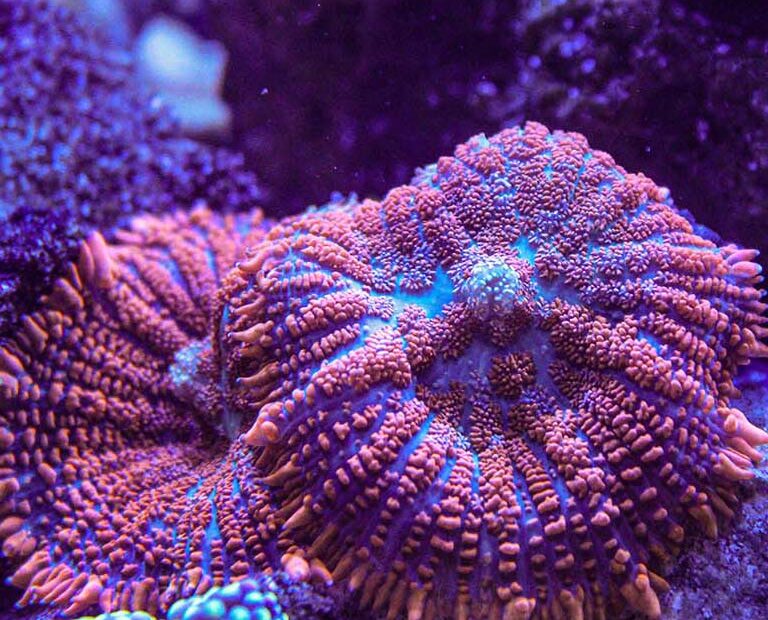Rhodactis Coral (Bullseye Mushroom)
• Common Name: Hairy Mushroom Coral, Tonga Mushroom, Bullseye Mushroom
• Scientific Name: Rhodactis spp.
• Class: Anthozoa
• Origin: Indo-Pacific, Australia, Red Sea, Fiji
• Category: Soft Coral
• Care Level: Beginner
• Temperament: Peaceful (but can spread aggressively)
• Lighting: Low to Medium (PAR 50-150)
• Flow: Low to Moderate (gentle, indirect flow)
• Placement: Bottom to Middle (best on rockwork or sandbed)
• Growth Rate: Fast
Overview:
Rhodactis mushrooms, commonly called Hairy Mushrooms or Tonga Mushrooms, are one of the most visually unique soft corals in the reef-keeping hobby. They are hardy, fast-growing, and easy to care for, making them an excellent choice for beginners. Unlike Discosoma, Rhodactis species have textured, fluffy tentacle-like structures that give them a “hairy” appearance.
Some Rhodactis mushrooms, like the Bounce Mushroom, are highly prized and can fetch premium prices due to their inflated vesicles that glow under LED lighting.
Tank Requirements & Water Parameters:
Rhodactis mushrooms are very adaptable and can tolerate a wide range of conditions, but they thrive best in stable environments:
• Temperature: 76-80°F (24-27°C)
• pH: 8.1-8.4
• Salinity: 1.024-1.026 SG
• Alkalinity: 7-10 dKH
• Calcium: 380-450 ppm
• Magnesium: 1250-1350 ppm
• Nitrate: 5-15 ppm (prefers moderate nutrients)
• Phosphate: 0.03-0.1 ppm
Unlike stony corals, Rhodactis corals prefer moderate nutrients and can thrive in tanks that are not ultra-low nutrient (ULNS) systems.
Lighting Needs:
• Low to moderate lighting (PAR 50-150) is ideal.
• Higher lighting may cause Rhodactis to shrink or “deflate” over time.
• They glow best under actinic or blue spectrum lighting, making them a popular choice for nighttime fluorescence.
If a mushroom starts moving away from its placement, it may be receiving too much light.
Flow Requirements:
• Low to moderate flow is best.
• Too much flow can cause Rhodactis mushrooms to detach and drift around the tank.
• They thrive in gentle, indirect currents where they can expand fully.
Feeding & Nutrition:
While Rhodactis mushrooms contain zooxanthellae and can survive on photosynthesis alone, they benefit greatly from supplemental feeding.
• Ideal Foods:
• Phytoplankton
• Reef amino acids
• Powdered coral foods (e.g., Reef Roids, Coral Frenzy)
• Finely chopped Mysis shrimp, brine shrimp, or fish eggs
Feeding 1-2 times per week can enhance growth, color, and polyp expansion. Some species can even engulf large prey, making them more carnivorous than typical mushrooms.
Placement & Aggression:
• Placement: Bottom to middle of the tank, often on live rock or rubble.
• Aggression: Peaceful, but they can spread aggressively and overgrow neighboring corals if left unchecked.
Tip: If you want to contain their spread, place them on an isolated rock or “mushroom island” to prevent them from overtaking the tank.
Growth & Propagation:
Rhodactis mushrooms grow quickly and reproduce in several ways:
1. Natural Division: A single mushroom splits into two or more over time.
2. Pedal Laceration: Small fragments left behind will regenerate into new mushrooms.
3. Manual Fragging:
• Use a sharp razor or scalpel to cut a mushroom into sections.
• Each section will regenerate into a full polyp within a few weeks.
• Attach frags to rubble using a rubber band or mesh until they adhere.
Popular Color Morphs & Variations:
Rhodactis mushrooms come in an incredible variety of colors and patterns, including:
• Rainbow Rhodactis – A mix of fluorescent greens, reds, oranges, and blues
• Tonga Hairy Mushroom – Large, fluffy tentacle-like texture
• Superman Rhodactis – Bright red with neon blue streaks
• Green Rhodactis – Intense green hues, fluoresces under actinic lighting
• Blue Rhodactis – Deep blues with subtle patterning
• Bounce Mushroom – Features large, inflated, bubble-like vesicles, highly sought-after in the reef hobby
Challenges & Common Issues:
• Spreading too aggressively: Rhodactis can quickly take over a tank if left unchecked. Keep them on isolated rocks or in dedicated mushroom zones.
• Detaching from rockwork: If stressed by high flow or poor conditions, they may let go and float. Secure them until they reattach.
• Color fading: Usually caused by excessive light or ultra-low nutrients. Lower lighting and feed regularly to maintain vibrancy.
• Melting or shrinking: Sudden parameter swings or exposure to toxins (like chemical warfare from soft corals) can cause mushrooms to deteriorate.
